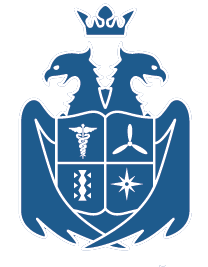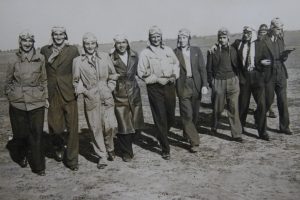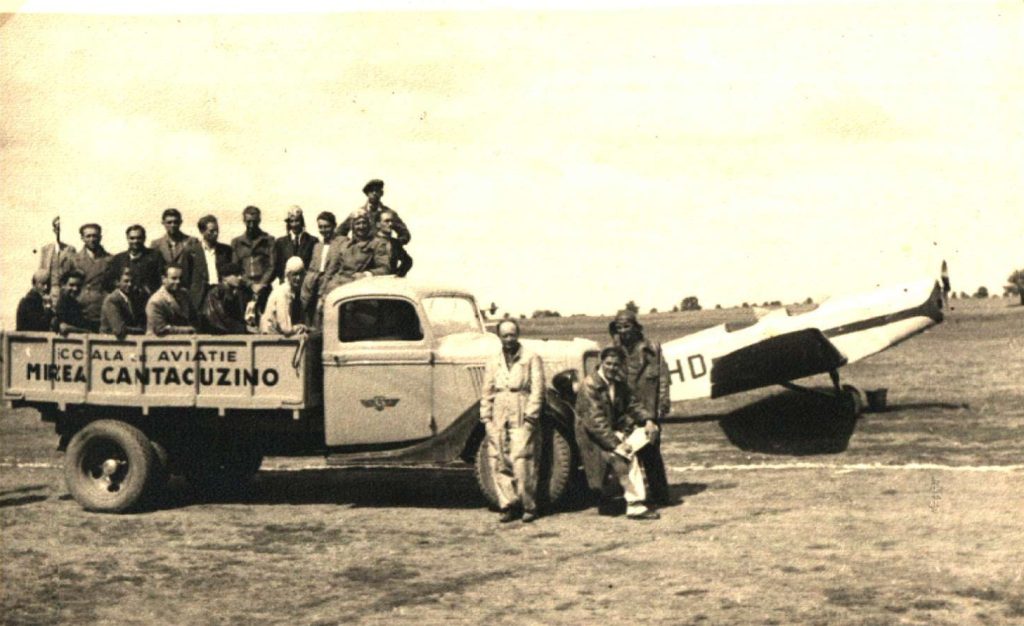Radu Manicatide
Born: 17th April 1912
Died: 18th March 2004
Place of birth: Iasi
Romanian aviation after the war
After the Second World War, during the years 1947-1948, the number of military pilots trained in Romania was continuously increasing, while the training planes used for that purpose were fewer and fewer. On February 1, 1949, the military aviation still possessed only 22 IAR-27 and 29 Fleet planes for elementary training, and for the second phase 55 Nardi planes, insufficient and used. In that situation, the Ministry of National Defense, through the Directorate of Aeronautics Endowment, began to take an interest in the planes that were produced abroad and especially in Czechoslovakia. In the end, the military aviators, led by General av. Mihai Romanescu-Leul, they came to the conclusion that only by building school airplanes in the country could the problem be properly solved. For this, contact was made with IMS-Braşov, the former IAR, which by virtue of the past, accepted with great difficulty to build a number of airplanes for the school in series. The former aircraft factory had in mind the difficulties they would encounter in organizing an aircraft manufacturing section, because they no longer had specialists and technical offices specific to this industry, it being reprofiled to the tractor industry. However, exceptionally, they undertook to study and execute during 1949 the prototype school plane, phase I, in three copies, without guaranteeing that they would ensure the performances required by the specifications.
The military aviation wanted a low-wing, wooden, winged, bilocked, side-by-side, mixed-construction, monoplane, welded-and-studded-steel-tube fuselage, with a fully enclosed cabin with hinged doors in flight. They insisted on the fixed landing gear, monojamb, which, due to the large number of runs it was going to do, had to be robust and with oleopneumatic shock absorbers.
The plane IAR-813
The IAR-813 plane was designed by engineer Radu Manicatide and was built according to the plans drawn up by the "Sovromtractor" Factories Study Bureau led by engineers I. Debău and V. Doichiţa.
On August 16, 1948, M.Ap.N. ordered the two identical prototype IAR-813 airplanes in Brasov and a series of only 25 pieces, because the civil aviation had in the meantime contracted the airplanes it needed in Czechoslovakia.
The first runway tour of the prototype IAR-813 airplane was performed on March 16, 1950, being piloted by Ioan Milu, an ace of our military aviation with over 35 aerial victories, followed by others. On June 23, 1950, test flights began plt. Maj. Vasile Stana. This, on the second flight performed on June 29, 1950, with foreman M. Unchi on board from the factory, left the work area, flying at low altitude above the hills. 2 kilometers from the town of Poiana Mărului and 25 from Braşov, entering a descent, it hit the tops of the trees, after which it was projected into a clearing, damaging the plane, but without much damage. Until then, the prototype plane had executed 80 percent of the flight test program and 304 landings out of the 500 required. The plane was repaired in a short time, after which it resumed its flights, piloted by the same Ioan Milu, until November 25, when they were finished.
The official homologation established that the IAR-813 plane was an ideal one for the school, intended for phase I instruction, and in terms of piloting finesse it more than fulfilled the qualities required even of a phase II plane, being able to be used for flight instruction without visibility.
As seen, the first 50 planes were intended for military piloting schools where, until 1955, they had completed more than 10,000 flight hours without major operational problems. In the years 1954-1955, another 30 pieces were manufactured for sports aviation. They were received in flight by lt. Av. Octavian Bacanu. Then, they also received 35 IAR-813 airplanes used by the military aviation which, through the respective transfer, wanted to support the material effort of the latter which offered them ready-trained and certified pilots, candidates for the military piloting schools. It can be appreciated that a large number of military and sports pilots were trained on that type of plane. Or, apart from the school flights, the plane enjoyed numerous appearances at air rallies, both in the country and abroad (Kiev, Moscow, Budapest) as well as several national records. That was the height record for the "Men" category set by Constantin Onciu with 6291 m, or the 6461 m, achieved by Elena Bulgaru for the "Women" category. Then the two national speed records on a closed circuit of 500 and 1000 km of 197.954 and 197.595 km/h, respectively, achieved in a single day by the pilot Bănică Enciulescu. Also, the three international speed records on a recognized route, approved by the International Aeronautical Federation, obtained by a formation of three IAR-813 planes, piloted by Ctin Onciu, Ctin Manolache and Simion Oţoiu on the route Bucharest-Kiev-Moscow-Kiev- Bucharest.
In 1961, 24 IAR-813 aircraft were given to the Ministry of Health, which, after reviewing them in Braşov, were put into operation. On that occasion, some of them had a hatch in the cabin floor for launching parachutes with bags carrying vials of blood, which were launched to hospitals located in regions without nearby airfields.
The IAR-813 was indeed a very successful aircraft, used in a wide range of missions, all performed in complete safety, from school and higher training flights to medical and glider towing. Continuing his series of successes, in 1955 Eng. Manicatide created a new form of fuselage construction, which apart from the two side doors and a hatch provided at the back, considered an invention and which continued in the IAR-818 type, built in large series. It was used as an agricultural, sanitary, light transport aircraft and equipped with floats as a seaplane. (IAR_818H).
Making other planes
Following this, this tireless constructor, until 1970, made a series of other airplanes, such as: IAR-817(1955), MR-2 (1956), IAR-818 (1960), IAR-818 H, IAR -821 (1967), IAR-821 B, IAR-822 (1970), IAR-823 and other prototypes.
Eng. Radu Manicatide was born in Iasi, on April 17, 1912, where he practiced aeromodelling during high school.
Gifted with a lot of intelligence, he attended the courses of the famous "Ecole Aeronautique et construction Automobile" Paris (1930-1834), where he was head of promotion, becoming an aircraft construction engineer.
During the holidays, back in the country, he proposed to continue the construction of flying models. He had his first success in 1926, when he won the national competition organized by the Romanian Aeronautical Federation with an airplane model executed on a larger scale, still proposing to learn to fly airplanes. Convinced that it will be necessary in his future activity, in 1933 he enrolled in the "Mircea Cantacuzino" piloting school, where he had among his colleagues Irina Burnaia, Bâzu Cantacuzino, Vasile Ciobanu and others. After the patent, he wanted to continue his flight training but it seems that he was determined from then on to continue dealing with aeronautical constructions. As proof, in a short time he completed the construction of the first phase glider, type "RM-1". According to what it seems, he put a motorcycle engine on it, doing flight tests on the Otopeni field, being appreciated as the first motor glider built in Romania. In 1932, the young man studying in Paris presented to the public the light airplane type "RM-4", which had an empty weight of 175 kg, and the engine was only 12 HP. Designed as a light tourist plane, it had a maximum speed of 80 km/h and a minimum speed of 50 km/h. It was followed by the "RM-5" model, a completely wooden construction made in 1935, whose total weight did not exceed 200 kg. For this reason it could be equipped with an engine of only 30 HP. Faithful to light constructions with low power engines, he also then presented the "RM-7" type whose engine had only 20 HP and was intended for touring pilots. Linked to his passion for "light aviation", the later ULMs, in 1942 he made in the workshops of the IAR factory, the "RM-9" sports and tourism plane, whose engine had only 32 hp, a single-seat plane that it had a great flight autonomy of 8 hours, during which time it could cover 1000 km.
The experimental glider "RM-10", an original construction, gave good results in the flights made on the Sânpetru slope, immediately after the war.
The "RM-11" plane, "Raţă" type, as written by the authors of the monumental work "Romanian Aeronautical Constructions, 1905-1970", had a horizontal wing in front of the pilot, and a 60 HP "Train" type engine in the back, the propeller being propulsive . The rectangular wings had a drift plane at the ends, with a rudder."
In 1953, this tireless seeker made the experimental type "RM-12", equipped with a 20 HP engine with only 2 cylinders driving a propulsive propeller and which had no ailerons. As it was written in the work mentioned above, "...piloting the plane was done with the help of the depth controls and by operating the direction planes..."
And all this apart from the achievements above.
Article by Vasile Tudor.





